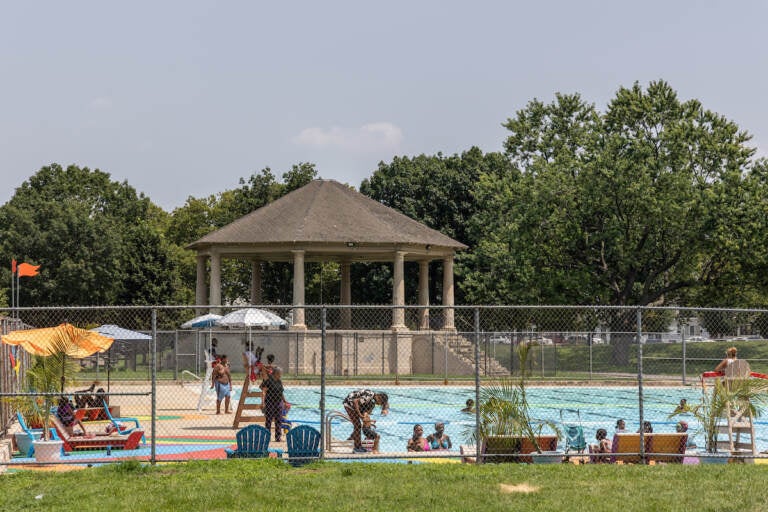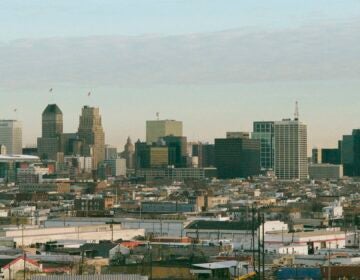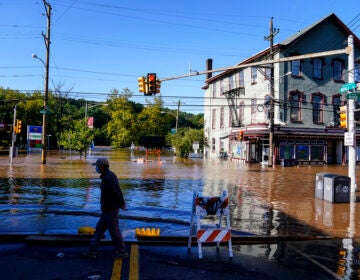Despite record global heat, Philly had coolest summer since 2014
Philadelphia recorded just one official heat-related death, the lowest count in 6 years.

Families take advantage of the public pool at the Hunting Park Recreation Center in Philadelphia on July 26, 2023. (Kimberly Paynter/WHYY)
Have a question about Philly’s neighborhoods or the systems that shape them? PlanPhilly reporters want to hear from you! Ask us a question or send us a story idea you think we should cover.
This summer was the world’s hottest since global records started in the late 1800s, due in part to El Niño.
But that wasn’t the case in Philadelphia. The city’s meteorological summer — from June 1 to August 31 — was relatively mild.
In fact, this summer was Philly’s coolest since 2014, with an overall average temperature below 76 degrees, according to the National Weather Service.
“As far as extreme heat, we just haven’t had it this year,” said Ray Martin, a meteorologist and lead forecaster at the National Weather Service’s Mount Holly office. “I think no one is complaining about that.”
Extreme heat is becoming more common around the world because of human-caused climate change.
Philly’s summers have been trending hotter in recent decades. Since 1970, the city’s average summer temperature has risen more than 3 degrees Fahrenheit, according to an analysis by the nonprofit research organization Climate Central.
A cool, smoky June
Philly’s mild summer was largely thanks to an unusually cool June. The average temperature that month was just above 70 degrees Fahrenheit — nearly 3 degrees below normal.
The reason was the wind pattern that brought both cool air and wildfire smoke down from Canada, Martin said.
“We had that northwesterly flow with all that air coming down from Canada, which kept us cool and smoky,” he said.
Philly’s cool June made July feel hotter. Average temperatures in July were close to 10 degrees hotter than in the month before, but were only slightly above normal. Nighttime lows were especially warm in July, averaging more than 2 degrees above normal.
“People acclimate. Their body kind of adjusts to ambient conditions,” Martin said. “It was a shock to a lot of people’s systems when summer finally actually showed up in July.”
August temperatures overall averaged around normal, but like in July, overnight lows were above normal.
Nationwide, nighttime temperatures are warming faster than daytime temperatures — a dynamic that can be particularly hard on people’s bodies. In Philly, overnight lows during the summer have warmed over a half a degree more since 1970 than average summer temperatures overall.
Few heat-related deaths
Philadelphia public health officials recorded just one heat-related death this summer, on July 28, a day with a high temperature of 94 degrees and an overnight low of 75.
This summer’s count of official heat-related deaths was the lowest since 2017, when the city recorded none, according to data provided by the Department of Public Health.
The city declared only one heat health emergency this summer, starting July 27. These declarations pause utility shutoffs and open cooling centers for residents with inadequate air conditioning at home.
Going forward, the city hopes to partner with community organizations to help provide respite from the heat during declared emergencies, “creating a robust and accessible network of resources,” said Office of Emergency Management spokesperson Jeffrey Kolakowski.
A record-hot start to fall
Philly had a steamy start to fall. Dozens of Philly public schools with inadequate air conditioning dismissed early during the first week back to school, as temperatures climbed into the mid-90s.
The average temperature over the first 13 days of September — above 79 degrees — was the warmest on record, going back to the 1870s. It exceeded the average for the 30-year normal period by more than 6 degrees.
“All the heat they’ve had out west and down south this summer … finally migrated in our direction,” Martin said.

Subscribe to PlanPhilly
WHYY is your source for fact-based, in-depth journalism and information. As a nonprofit organization, we rely on financial support from readers like you. Please give today.








